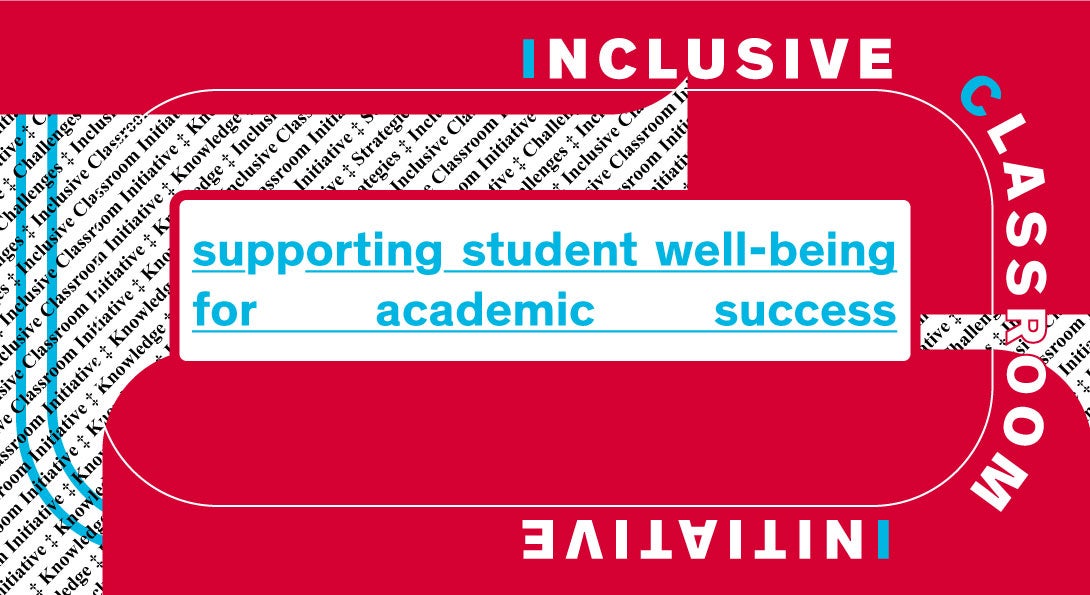Supporting Student Well-being for Academic Success

Log in to Access This Module
Introduction
This module is designed to provide faculty with practical skills to use to prioritize and support student well-being within all aspects of their courses.
Our role as educators is to facilitate learning; to provide students with equitable opportunities to gain knowledge and experience that will serve them in their professional lives. While it is not any faculty member’s responsibility to clinically address student mental health, we know that student mental health and well-being is inextricably linked to academic success. It is therefore within faculty’s core purpose, and in students’ best interest, to implement strategies that support students holistically; that truly enable our students to thrive.
This module, “Supporting Student Well-being for Academic Success,” will introduce you to teaching strategies that can be applied in any classroom context, regardless of what you teach or where you teach, with particular consideration to who you teach. We will review the needs of today’s students, looking closely at their specific challenges around mental health and well-being, and explore ways to better support them, and in turn, support yourself. You’ll hear directly from UIC students in this module and explore inclusive teaching strategies at a wide variety of levels. As you’ll see, small changes can have a big impact.
Credits
| Faculty Fellow, Content Developer | Leah Goodman |
| Storyline Designer | Kyra Jones |
| Content Support | Michelle Manno |
| Kim Rivas | |
| Hilary Short | |
| Media Designer | Kyra Jones |
Thanks
Special thanks to the many UIC students, especially Zoie, Liv, and Paul, for sharing their experiences with us and agreeing to be a part of this module. Additional thanks to our pilot group participants from across UIC for their helpful feedback during the creation of this module.
Supplemental Resources
These resources, compiled by our faculty fellow and content developers, accompany the module and provide additional detail. They include important information from colleagues at UIC and other institutions who promote and study inclusive classrooms. Please see the module “Supporting Student Well-Being for Academic Success” for more information on how you can implement some of these strategies in your classroom!
x
Putting a land acknowledgement in your syllabus is the first of many steps you can take to cultivate a sense of belonging for indigenous students. It must be followed, however, by additional support.
Exit-Tickets
Exit tickets are an inclusive teaching tool that serves a variety of purposes. Often used at the end of a class period, exit tickets can be a useful way to check in with students about what they learned, what might still be confusing for them, or any other important information. If you tried a new exercise in class, exit tickets can be a useful way to ask students for feedback. Exit tickets can also be used as alternative forms of participation for students who struggle to participate verbally during class. If you’re teaching online, students can send exit tickets via email or through Blackboard posts.
This resource developed by Brown University’s Sheridan Center for Teaching and Learning offers several examples of ways to use exit tickets in your class.
Inclusive Language
Using inclusive language is an important part of creating an inclusive classroom environment for all of your students. In addition to learning students’ names and pronouns, there are other ways to make your language more inclusive, particularly as it relates to students’ religious affiliations or other social identities. As outlined in the University of Michigan’s “Setting the Tone for Inclusive Classrooms,” consider the following:
“While speaking in class, mark as particular to only some students’ experiences that many may assume are shared by all (e.g., living in a house, being cared for by two parents, regularly taking vacations). You can use phrases such as, “For those of you who have been on an airplane,” or “If you grew up with siblings to whom you were biologically related…” This can help normalize and destigmatize experiences that are possible points of marginalization for your students.”
Language is powerful and being thoughtful about how we say things can make a difference in whether our classrooms feel like welcoming spaces for all of our students.
Content + Trigger Warnings
As outlined in the UIC Center for the Advancement of Teaching Excellence (CATE) syllabus template, “Some courses include readings, videos, discussions, or other presentations on topics that may be emotionally distressing or difficult for some students or include explicit images or language that some students find offensive. In recognition that our students have lives, histories, and struggles about which instructors are not necessarily aware or in a position to understand, consider including in your syllabus content notices, which are verbal and written notices that precede potentially sensitive content, and trigger warnings, which are a type of content notice that attempts to forewarn students of content that may cause intense physiological and psychological symptoms for people with anxiety disorders and other mental health disabilities related to personal traumas.”
In addition to providing content notices and trigger warnings in your syllabus, you may also want to offer verbal reminders during class and/or written reminders via email or Blackboard for those who miss class. For several examples on how to offer such notices, see the CATE syllabus template as well as the following resources from other Universities.
Classroom Agreements
Classroom agreements (otherwise known as “norms” or “ground rules’) are helpful guidelines for students to understand how to respectfully engage in class and in relation to each other. Classroom agreements should be shared with students ahead of time and discussed. It’s especially effective if students have the opportunity to add agreements that would be helpful for their own learning and engagement. Classroom agreements can be posted on Blackboard and/or hung up in a physical classroom space so that they can be referred back to often; this can be especially useful during difficult conversations. For examples of classroom agreements, see the resources below.
Process-Oriented Feedback
Process-oriented feedback or “process praise” has been shown to influence students’ academic success, how they approach setbacks, and their overall effort. As Allison Masters writes in a Mindset Scholars Network article on praise, “process praise that emphasizes students’ effort or strategy is more likely to lead to resilient responses after negative feedback or failure.” Person-oriented feedback—”you’re great”—focuses on the person and emphasizes an internal cause for success or failure. On the other hand, process-oriented feedback—”how you came to that answer was creative”—focuses on the process and emphasizes an external cause for success or failure. During a setback, process praise helps a student see that with effort or a change in strategy, they might have better success next time. Thinking, for example, “I need to come up with a new strategy to solve this problem” instead of “I’m no good at math” matters a great deal in whether a student will persist in the face of academic challenges. Ultimately, the kinds of feedback we give students can impact their mindsets around their own abilities which in turn influences their motivation, effort, and eventual success in our classes.
x
Research shows that when a significant event occurs outside of the classroom, students prefer faculty to do something rather than nothing. In their study on students’ perceptions of helpful faculty responses following collective tragedies, Huston and DiPietro (2007) demonstrate that students appreciated when faculty mentioned the event and even more so when they recognized students’ distress and attempted to offer extra support. Importantly, the authors argue that “an instructor’s response need not be complicated, time-intensive, or even personalized” (13).
When it comes to instances within the classroom, particularly around racial tension, Harper and Davis (2016) demonstrate that students are disappointed when instructors do not meaningfully address or engage with what happened. Rather than shutting down conversations, we can use these moments for learning opportunities. Even if you can’t engage in a dialogue about the incident at that moment, directly addressing that it happened is key. For more on managing difficult dialogues in the classroom, see the following resources:
References
Buckholdt, D. R., & Miller, G. E. (Eds.). (2013). Faculty stress. Routledge.
Buskirk-Cohen, A. A., & Plants, A. (2019). Caring about Success: Students’ Perceptions of Professors’ Caring Matters More than Grit. International Journal of Teaching and Learning in Higher Education, 31(1), 108-114.
Eisenberg, D., Golberstein, E., & Hunt, J. B. (2009). Mental health and academic success in college. The BE Journal of Economic Analysis & Policy, 9(1).
Krumrei-Mancuso, E. J., Newton, F. B., Kim, E., & Wilcox, D. (2013). Psychosocial factors predicting first-year college student success. Journal of College Student Development, 54(3), 247-266.
Marks, R., Kernan, W., Bogart, J., & Wheat, M. E. (2011). Health‐related barriers to learning among graduate students. Health Education.Sherman, M. C. (2019). In Their Own Words: A Phenomenological Exploration of Student Mental Health and Success in College. Social Work Research, 43<(3), 145-156.
Faculty Fellow

Dr. Goodman developed and teaches “Promoting Wellbeing”, a credit-bearing course which aims to support student wellness and academic success. She also teaches “Human Sexuality and Health Science”, and mentors undergraduate and graduate students. Her scholarship and work focuses on cultivating student mental health and wellbeing. Leah serves as faculty advisor for the Mental Health and Disability Alliance and is an Honors College Fellow. She is interested in exploring the ways we define and provide student support, and seeks to develop initiatives that promote wellbeing, health, and equity.
| Supporting Student Wellbeing